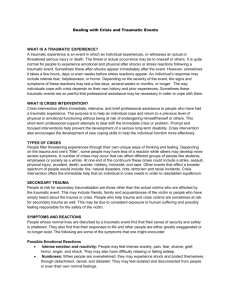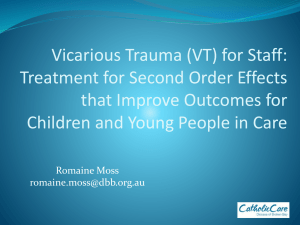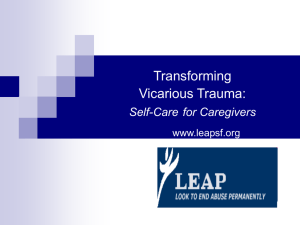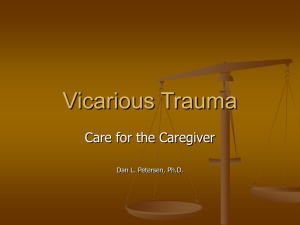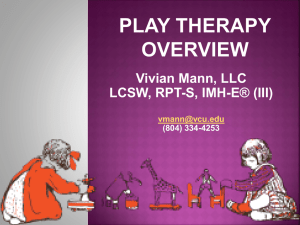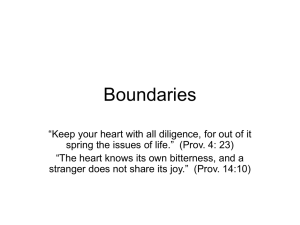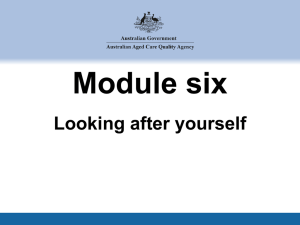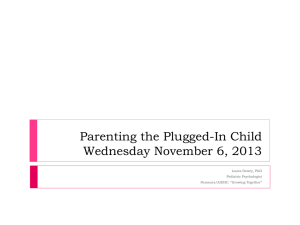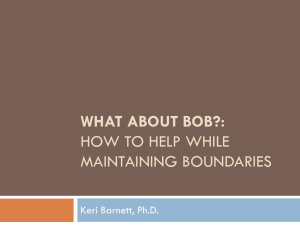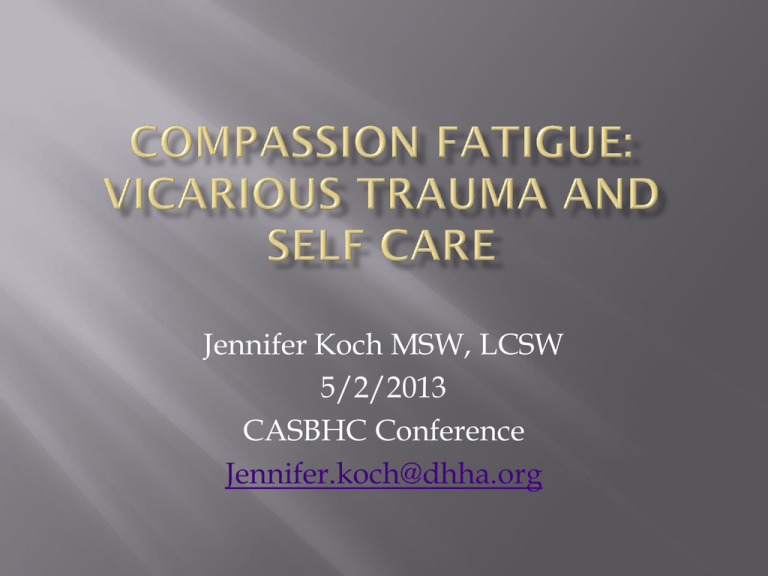
Jennifer Koch MSW, LCSW
5/2/2013
CASBHC Conference
Jennifer.koch@dhha.org
The following personal financial relationships
with commercial interests relevant to this
presentation existed in the past 12 months:
No relationships to disclose
Define:
Burnout
Countertransference
Projective identification
Vicarious Trauma
Discuss trauma, it’s symptoms, impact on helpers
Discuss self care and coping skills to manage VT
Resources for SBHC staff
Vicarious traumatization (VT)
Secondary post traumatic stress reaction
Secondary traumatic stress
Secondary traumatic stress disorder
Compassion fatigue
Compassion stress
Soul sadness
Empathic strain
Contact victimization
It’s not a matter of “If” it’s a matter of “When”
“There is a soul weariness that comes with caring.
From daily doing business with the handiwork of
fear. Sometimes it lives at the edges of one’s life,
brushing against hope and barely making its
presence known. At other times, it comes
crashing in, overtaking one with its vivid images
of another’s terror with its profound demands for
attention; nightmares, strange fears, and
generalized hopelessness.”
B. Hudnall Stamm, Ph.D.
Burnout:
Related to feeling of being overloaded
Work stress
Joy of work is lost
Can occur in any professional setting
Progresses gradually as a result of emotional
exhaustion, cynicism, and feelings of inefficacy.
Does NOT lead to changes in trust, feelings of
control, issues of intimacy, safety concerns, and
intrusive traumatic imagery that are foundational to
Vicarious Trauma.
The process of seeing oneself in the patient, of overidentifying with the patient, or of meeting one’s own
needs through the patient.
Counter-transference occurs when the clinician begins
to project his or her own unresolved conflicts onto the
patient.
Good clinicians are those who can tune into their own
countertransference feelings and quickly assess
whether it is coming from them or the patient. This is
one of the reasons it is so important for clinicians to do
their own work.
The result of developmental impingement that occurred
before the patient had acquired language (pre-verbal).
Since patient has no language to communicate their
internal struggles, they induce the feelings in another in
order to be understood.
Both a defense mechanism and a mode of
communication.
As a defense mechanism… it creates a psychological
distance from unwanted (often frightening) aspects of
the self.
As a mode of communication… patient’s own feelings
are induced in another person (therapist/helper),
creating a sense of being understood by the other
person.
Vicarious trauma is the process of change that
happens because you care about other people
who have been hurt, and feel committed or
responsible to help them. Over time this
process can lead to changes in your
psychological, physical and spiritual wellbeing. (Headington Institute)
Cumulative –happens over time as you work
with survivors of trauma, disasters, people
who are struggling.
Process of change is ongoing – this is hopeful
as it provides opportunities for us to recognize
the impact the work has on your lives early and
to develop strategies to protect and care for
ourselves.
Empathy
When you identify with the pain of people who
have endured terrible things, you bring their
grief, fear, anger, and despair into your own
awareness and experience.
What sort of problems or people do you find it easy
(or difficult) to empathize with?
What are some ways that caring about people who
have been hurt affects you?
Feeling committed or responsible to help
Your commitment and sense of responsibility can lead
to high expectations and eventually contribute to your
feeling burdened, overwhelmed, and
hopeless/helpless.
Can lead you to extend yourself beyond what is
reasonable for your own well-being or the best longterm interests of your patients.
How does your sense of commitment and responsibility to
your work help you? How might it be hurting you?
The empathic process:
Merging touches our own unresolved issues – our
countertransference
Joining supports differentiation between you and
patient– being attuned/in resonance/healthy
boundary
Patients whose boundaries have been so
abused/ruptured – it may be nearly impossible for
them to maintain appropriate boundaries. It is essential
that we have or develop healthy boundaries as
clinicians.
Patients with borderline characteristics will merge
easily and violate boundaries frequently and ask us to
violate our boundaries
Warning signs of merging:
Something will happen in our system to decrease our contact with
our felt sense
We are uncomfortable with someone who dissociates or leaves
their body
We’re not ok until they are ok
We feel unsettled, unclear, tired, not present
Think about patient outside of session more often than our
comfort level
We think we are indispensable – were are the only ones who can
help
Boundaries get blurred – we go overtime, stay late, we start taking
on their stuff, have dreams about them
Joining
We need to be grounded and in our bodies and resourced
ourselves
Can’t prevent merging but reset boundaries after this happens
Ask how does merging touch our own stuff? What shadow piece
of me is showing up?
Don’t get too caught up in their story
Stay present within your boundaries without withdrawing – helps
patient begin to develop trust
Come back to your belief in the patients own ability to heal. And
the knowledge that they have taken care of themselves for years
without us and will continue to do so
Respect their need for boundaries – on both sides of the
relationship
Changes in spirituality
Your deepest sense of meaning and purpose, hope,
faith
Humanitarian workers often refer to this as
“existential angst” - being constantly pushed out of
your comfort zone and forced to question the
meaning of events, and their own and others actions
and reactions.
What are some ways your work has had a positive
influence on the way you see the world, yourself, belief
in God, what matters to you? In what ways has the
influence been negative?
Understanding risk factors:
Personality and coping style
Personal trauma history
Current life circumstances
Social support
Spiritual resources
Work style – work/life boundaries
Professional role/work setting/degree of exposure
Agency support
Affected populations response or reaction
Cultural styles of expressing distress and extending and
receiving assistance
Feeling frustration or anger about a patient’s choices
Thinking about a patient outside of work more than
you want to
Feeling anxious about working with a patient
Feeling dread when you anticipate seeing a patient
Feeling more worried than you think is necessary
about a patient
Feeling angry at a patient
Feeling de-skilled or incompetent when you meet with
a patient
Taking on too much responsibility- difficulty leaving
work at end of day – stepping in to control other’s lives
Feeling disconnected or dissociated from the patient,
their emotions or the content of the session
Having physical discomfort or pain while meeting
with a patient, which seems connected with what
you’re working on
Having other physical reactions to a patient’s stories,
e.g. increased heart rate, rapid or shallow breathing,
nausea, feeling frozen etc.
Feeling traumatized after talking with a patient about
specifics of their abuse
Wanting to cry during/after meeting with a patient
Feeling helpless about your work with a patient
Feeling enraged at a patient’s perpetrators
A - Stressor – The traumatic material
B- Re-experiencing traumatic event
Intrusive recollections of traumatized patient (TP)
Dreams about TP patient
Reminders of TP’s traumatic event
C- Avoidance/Numbing
Efforts to avoid thoughts/feelings or patient
Efforts to avoid activities/situations
Detachment, estrangement from others, diminished affect
D- Persistent Arousal
Sleep disturbance
Problems concentrating
Exaggerated startle response
Irritability/outbursts of anger
Response to triggers – physiologic reactivity to cues
Tips for managing provider
helplessness/hopelessness
Important to believe deeply in the resiliency of the
human spirit (YOURS and THEIRS)
Avoid sending message verbally or non-verbally
that you don’t believe they can handle ‘it’ – its
disempowering
There is BLUE in every RED
Ask BLUE questions to highlight resourcing and
resiliency already in place for your patient
“When did you first know you were safe?”
“Where do you get your strength from?”
Don’t attempt to introduce more activation into
the nervous system of your patient if they
appear flat – this is actually the highest degree
of charge in their nervous system.
Support orientation.
Titration is important helping patient to
pendulate between SNS and PNS, creating a “I
can” experience for them.
What helps?
An effective action plan for addressing
vicarious trauma and self care will reflect your
own needs, experiences, interests, resources,
culture, and values.
Escape – get away from work/trauma material
Rest – do things you find relaxing
Play – physical activity, creativity, laugh
Tools of transforming helplessness
Awareness – Being attuned to own needs, limits, emotions,
reactions, resources. Mindfulness and acceptance. Keep mind
and body in same place.
Balance – Professional and personal – rest/work/play. i.e.
Eat lunch/go home at end of shift. Spend time laughing with
friends
Connection – To oneself, others, something larger. Decreases
isolation, increases validation and hope. An essential part of
spiritual connection is to find one’s own path to connecting
with a sense of awe, joy, purpose, meaning, and hope and
visiting it frequently.
Yoga/ Tai Chi /Dance
Long baths/aromatherapy
Mindful eating
Biking, hiking, running
Journaling, singing
Massage
Travel
Time with friends
Personal psychotherapy
Sex
Eat and sleep
Laugh
Seek spiritual renewal/pray
Meditation
Hobbies, sports, creative interests
Gardening/baking
Bubble baths/movie night
Forgive yourself
Walking/petting dog
Establish boundaries separating work from home
Guard against addictive behaviors
Acupressure/tapping
Seek out experiences which instill hope and comfort
Talk with co-workers about self care strategies that
work – share ideas
Filling the basket
Water returning to earth
Showering imagery
Take 2-3 minutes to be still in between appointments
Develop containment strategies
Prioritize your own well-being over your patients
Why do you do this work?
How do you measure success in your work?
What can you control in your work?
What are the costs and rewards of this work
and how are you personally changing?


